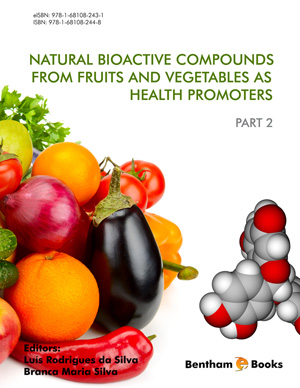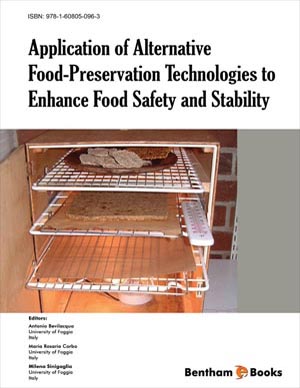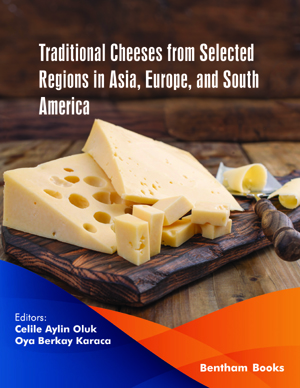Foreword
Page: i-ii (2)
Author: Jose Alberto Pereira and Susana Casal
DOI: 10.2174/9781681082431116010001
List of Contributors
Page: iv-vi (3)
Author: Luis Rodrigues da Silva
DOI: 10.2174/9781681082431116010003
Bioactive Compounds of Legumes as Health Promoters
Page: 3-26 (24)
Author: Luis R. Silva, Alvaro Peix, Carlos Albuquerque and Encarna Velazquez
DOI: 10.2174/9781681082431116010004
PDF Price: $15
Abstract
Legumes are a wide group of plants worldwide cultivated by the high nutritional quality of their seeds containing fibre, proteins, resistant starch, minerals and vitamins. The milk obtained from seeds of some legumes, mainly soybean, is used to obtain fermented products currently widely consumed as probiotics. Moreover, legumes are considered as nutraceuticals since they contain bioactive peptides (BAPs) and many phytochemicals endowed with useful biological activities. Legume BAPs have antioxidant, antihypertensive, hypocholesterolemic and antithrombotic activities. Flavonoids and particularly isoflavones have beneficial effects in different cancer types, have been related with lower cardiovascular risk and are protective against fatty liver disease, obesity, diabetes and other metabolic disorders.
Hydrophilic phytochemicals, such as ascorbic acid (vitamin C), phenolic acids and polyphenols, have been associated with a reduction of cancer risk and an enhancement of the immune system functionality. Lipophilic phytonutrients, such as carotenoids and tocopherols, may prevent the risk of cardiovascular diseases. In this chapter we revise the recent works focusing on legume bioactive compounds and human health prevention.
Bioactive Compounds from Brassicaceae as Health Promoters
Page: 27-47 (21)
Author: Nieves Baenas, Marta Francisco, Pablo Velasco, María Elena Cartea, Cristina García-Viguera and Diego A. Moreno
DOI: 10.2174/9781681082431116010005
PDF Price: $15
Abstract
This work provides an up to date review of the information available about bioactive compounds present in the Brassicaceaefamily (glucosinolates, phenolics and vitamins) in relation to human health. The Brassicaceaeplant family includes a large variety of species and cultivars, some of the most known are Brassica oleracea (e.g. broccoli, cabbage, Brussels sprouts), Brassica rapa (e.g. turnips), Brassica napus (e.g. rapeseed), Raphanus sativus (radishes), and Sinapis alba (mustards). In the recent years, these crops are increasingly consumed for possible health benefits as a good source of bioactive compounds. The sulphur containing compounds glucosinolates are almost exclusively found in this family, being their beneficial health effect supposed to be induced by their hydrolysis products, the isothiocyanates. In in vitro (human cell lines) and in vivo studies (animal models and human intervention assays) isothiocyanates have demonstrated their protective effects in carcinogenesis, chronic inflammation and neurodegeneration. The phenolic compounds mainly studied are flavonols, anthocyanins and hydroxycinnamic acids, which principal bioactivity is their antioxidant capacity. The carotenoids β-carotene, lutein and zeaxanthin, as well as, vitamins C, E and K have also been considered as nutrients with biological activity. The phytochemical wealth of Brassica foods is gathering attention from the scientific community for being potentially protective for the cardiovascular system and against certain types of cancer, and neurological disorders, mainly because of their antiinflammatory and antioxidant properties.
Even it is not yet possible to recommend a particular “daily dose” for human consumption of cruciferous foods for disease prevention, there is growing evidence regarding the protective effects of Brassica bioactive compounds for health via regulation of signaling pathways and cellular metabolism.
Bioactive Compounds of Tomatoes as Health Promoters
Page: 48-91 (44)
Author: Jose Pinela, M. Beatriz P. P Oliveira and Isabel C.F.R. Ferreira
DOI: 10.2174/9781681082431116010006
PDF Price: $15
Abstract
Tomato (Lycopersicon esculentum Mill.) is one of the most consumed vegetables in the world and probably the most preferred garden crop. It is a key component of the Mediterranean diet, commonly associated with a reduced risk of chronic degenerative diseases. Currently there are a large number of tomato cultivars with different morphological and sensorial characteristics and tomato-based products, being major sources of nourishment for the world’s population. Its consumption brings health benefits, linked with its high levels of bioactive ingredients. The main compounds are carotenoids such as β-carotene, a precursor of vitamin A, and mostly lycopene, which is responsible for the red colour, vitamins in particular ascorbic acid and tocopherols, phenolic compounds including hydroxycinnamic acid derivatives and flavonoids, and lectins. The content of these compounds is variety dependent. Besides, unlike unripe tomatoes, which contain a high content of tomatine (glycoalkaloid) but no lycopene, ripe red tomatoes contain high amounts of lycopene and a lower quantity of glycoalkaloids. Current studies demonstrate the several benefits of these bioactive compounds, either isolated or in combined extracts, namely anticarcinogenic, cardioprotective and hepatoprotective effects among other health benefits, mainly due to its antioxidant and anti-inflammatory properties. The chemistry, bioavailability and bioactivity of these bioactive compounds will be discussed, as well as the main mechanisms of action against cancer and other bioactivities including antioxidant, antiinflammatory, cardiovascular and hepatoprotective effects in humans. Possible applications of tomato bioactive compounds in the industry will also be proposed.
Bioactive Compounds from Capsicum annuum as Health Promoters
Page: 92-109 (18)
Author: Adriana M. S. Sousa, Lorena Carro, Encarna Velàzquez, Carlos Albuquerque and Luis R. Silva
DOI: 10.2174/9781681082431116010007
PDF Price: $15
Abstract
Capsicum annuum (Pepper) is an agricultural crop of the Solanaceae family which is important as a vegetable food (bell pepper), as a spice (chili pepper), and as a colorant (paprika). It is native to Mexico and Central America but it is consumed worldwide and used in a great variety of dishes depending on its texture, flavor and color. C. annuum is a good source of bioactive compounds, such as polyphenols (flavonoids and phenolic acids), capsaicinoids, capsinoids, carotenoids and vitamins, with well-known anti-oxidant and anti-inflammatory effects. Since the human body cannot produce many of these compounds, this crop assumes an important role in health protection, and might present new pharmacological solutions to several conditions. In this chapter, we aim to summarize the phytochemical composition of C. annuum and emphasize the major and most recent findings concerning health promoting benefits of its bioactive compounds (polyphenols, capsaicinoids, capsinoids, carotenoids, vitamins, and phytosterols), particularly those related with anti-oxidant, anti-nociceptive, anti-neoplastic, and anti-obesity properties.
Phytochemical, Nutritional, Antioxidant and Anticancer Properties of Juglans regia (L.)
Page: 110-131 (22)
Author: Branca M. Silva, Ana R. Nunes, Elsa Ramalhosa, Jose A. Pereira, Marco G. Alves and Pedro F. Oliveira
DOI: 10.2174/9781681082431116010008
PDF Price: $15
Abstract
Juglans regia (L.) is a deciduous tree, spread throughout the world due to its nutritional and sensory value. Although walnuts, the J. regia seeds, have been part of the human diet for a long time, only in the recent years several studies have surfaced on this botanical species as a rich and inexpensive source of bioactive compounds. In fact, much research is available depicting the human health benefits of J. regia seeds, leaves and green husks for a wide variety of diseases mediated by oxidative stress, namelly cancer, and neurodegenerative disorders. Among bioactive compounds, polyphenols play an important role. They are well known for their strong antioxidant, antihemolytic, antidiabetic, antimicrobial, antimutagenic and anticarcinogenic activities and are considered by many researchers responsible for the beneficial health effects of J. regia and its derivatives. In this chapter, we aim to emphasize the phytochemical composition, nutritional value and health promoting properties of J. regia, especially those related to its antioxidant and anticancer activities. Among several nut types, walnut stands up as a functional food, rich in antioxidants, especially in phenolic compounds and tocopherols. The potential for J. regia to be used as both preventive and therapeutic measure in several human diseases is high. For that reason, a lot of attention has been given to J. regia in the last decade.
Our chapter, summarizes the main studies about J. regia and its beneficial effects on human health, focusing on its antioxidant and anticancer activities.
Bioactive Compounds of Chestnuts as Health Promoters
Page: 132-154 (23)
Author: Teresa Delgado, Jose A. Pereira, Susana Casal and Elsa Ramalhosa
DOI: 10.2174/9781681082431116010009
PDF Price: $15
Abstract
Different chestnut species can be cultivated for fruit production, the most valorised part for nutritional purposes. However Castanea sativa Mill., the “European chestnut”, is one of the most valorised worldwide. Its fruits are consumed either raw or after processing, being boiling and roasting the most usual ones. The nutritional composition of fresh chestnut is variable, with interesting amounts of carbohydrates and fibre, together with low fat content, with differences between cultivars and producing regions. In respect to the presence of bioactive compounds, such as phenolic compounds, vitamins, fatty acids, among others, some studies had focused on the fruit benefits to human health but few reported the effect of processing in those compounds. In this context, this chapter intended to review the current knowledge on chestnut composition, together with the influence of diverse post-harvest technologies, such as refrigeration, flame peeling, freezing with CO2, irradiation, boiling and roasting on the bioactive compounds of chestnut.
Bioactive Compounds of Hazelnuts as Health Promoters
Page: 155-179 (25)
Author: Joana S. Amaral and M. Beatriz P.P. Oliveira
DOI: 10.2174/9781681082431116010010
PDF Price: $15
Abstract
Hazelnut (Corylus avellana L.) belongs to the Betulaceae family and is one of the most popular and commonly consumed tree nuts worldwide. Hazelnuts are highly nutritious, providing macronutrients (fat, protein and carbohydrates), micronutrients (vitamins and minerals) and several bioactive phytochemicals. So far, different phytochemicals have been described in hazelnuts, such as phenolic acids, flavonoids, condensed tannins and phytosterols. Among the array of phytochemicals present in hazelnuts, several have been associated with interesting properties such as antioxidant, anti-inflammatory, anti-proliferative and hipocholesterolemic activities thus potentially contributing for beneficial health effects related to hazelnut consumption. Even though hazelnuts have a high fat content, its inclusion has been recommended as part of a healthy-diet. The health benefits of hazelnut consumption have been mainly associated with its favourable lipidic composition and fat-soluble bioactives but also to its content in other compounds such as L-arginine and antioxidant phytochemicals. This chapter aims at providing detailed and up-to-date information on hazelnut bioactive compounds composition and related health aspects, including data from epidemiological and clinical studies.
Bioactive Compounds in Coffee as Health Promotors
Page: 180-220 (41)
Author: Mafalda C. Sarraguca, Ricardo N.M.J. Pascoa, Miguel Lopo, Jorge M.G. Sarraguca and Joao A. Lopes
DOI: 10.2174/9781681082431116010011
PDF Price: $15
Abstract
Coffee is the most consumed beverage in the world after water. In 2014 approximately 141 million tons of coffee bags were produced. In terms of international trade only crude oil has a bigger share. The world coffee trade is increasing every year showing the importance of coffee to the world economy. The composition of the two main coffee species (Arabica and Robusta) varies according to the origin, storage and terroir conditions. During the roasting process there are a number of reactions that give rise to the organoleptic properties of coffee. The main bioactive compounds in coffee are chlorogenic acids, caffeine, trigonelline, melanoidins and diterpenes. These compounds are known to have a number of beneficial health effects. Many epidemiological studies suggest that coffee consumption can lead to health benefits in several diseases such as type 2 diabetes, several types of cancers, Parkinson’s and Alzheimer’s disease. These benefits are related with coffee antioxidant, antiinflammatory, anti-mutagenic and anti-carcinogenic properties. Chlorogenic acids are known to have chemopreventive and anticarcinogenic activities and also to act as antithrombotic agents. Caffeine is the most recognized bioactive constituent of coffee and can have a number of positive effects in health, most of them associated with the antagonism of the A1 and A2 subtypes of the adenosine receptor. Its stimulatory effect is due to the synergetic interaction with adrenalin and noradrenaline. Trigonelline is connected to neuroprotective, estrogenic, hypoglycemic, anti-invasive, and antibacterial responses.
The biological activities commonly associated with melanoidins are antioxidant and metal chelating, antimicrobial, and anticarcinogenic. These compounds also have the ability to modulate colonic microflora. Research has showed that the diterpenes, cafestol and kahweol have a chemopreventive potential by enhancing defense systems against oxidative stress. It is clear from the epidemiological studies that coffee has indeed health benefits. Nevertheless some caution has to be taken into account since there are a number of issues regarding these studies, as many of them were not designed specifically for coffee. Furthermore, health problems history and individual lifestyle can introduce misleading factors.
Bioactive Compounds of Rice as Health Promoters
Page: 221-234 (14)
Author: Charu Lata Mahanta and Sangeeta Saikia
DOI: 10.2174/9781681082431116010012
PDF Price: $15
Abstract
Rice (Oryza sativa L.) is one of the major cereal food crops in the world. It serves as a principal source of carbohydrate. Rice is also traditionally used for therapeutic purposes. The health promoting properties of brown rice has generated research interest. The health promoting properties are attributed to the bioactive compounds in the rice bran. These include vitamins, minerals, phenolic compounds, γ - oryzanol, tocopherols, tocotrienols, anthocyanins, phytosterols and dietary fibre. The concentration of bioactive properties is more in pigmented rice varieties. The bioactives in rice impart cholesterol reduction, anti-inflammatory, anti-tumor, anti-diabetic and anti-oxidative effects. Ferulic acid is the major phenolic acid in rice whose esters predominantly form γ-oryzanol and remains in the human blood stream for longer time than other phenolics thereby offering greater radical scavenging efficiency. The rice bran anthocyanin pigments contribute to the total phenolic and antioxidant properties of rice to a notable extent. The tocols also are potent antioxidants. Both in vivo and in vitro experiments have ascertained the effect of these compounds in animals and human beings. The bioactive potential of rice has been found to widely vary with variety, extent of polishing and processing. Cooking steaming, parboiling, fermentation and germination of rice result in marked changes in proportion and activities of different bioactive components. This chapter focuses on the bioactive compounds in rice, the potential health benefits of rice consumption, and processing effects on bioactivity.
Subject Index
Page: 235-237 (3)
Author: Luis Rodrigues da Silva and Branca Maria Silva
DOI: 10.2174/9781681082431116010013
Introduction
Plants have been widely used to treat diseases, owing to the presence of bioactive compounds (phytochemicals) which play important roles in health promotion and disease prevention. In recent years, advances in chemical extraction techniques, lifestyle and dietary choices for human health have increased the interest in the consumption and study of fruits, vegetables, and foods enriched with bioactive compounds and nutraceuticals. Thousands of dietary phytochemicals, such as flavonoids, phenolic acids, glucosinolates, terpenes and alkaloids, have been identified and categorized further according to a diverse array of biochemical properties. Many of these phytochemicals have been hypothesized to reduce the risk of several pathological conditions which include life threatening diseases such as heart disease and cancer, to name a few. Natural Bioactive Compounds from Fruits and Vegetables as Health Promoters is a 2 book set which presents a summary of different classes of phytochemicals commonly found in common edible food sources. Each chapter details the general chemical structures of compounds, naturally present in specific fruits, vegetables and grains, their biological importance and mechanisms of action. The book set is an essential handbook for anyone interested in the natural product chemistry of these common crops. Part 1 of this set covers details about different fruits (banana, citrus fruits, pears, etc.). Part 2 covers legumes, nuts, seeds and cereals.



















